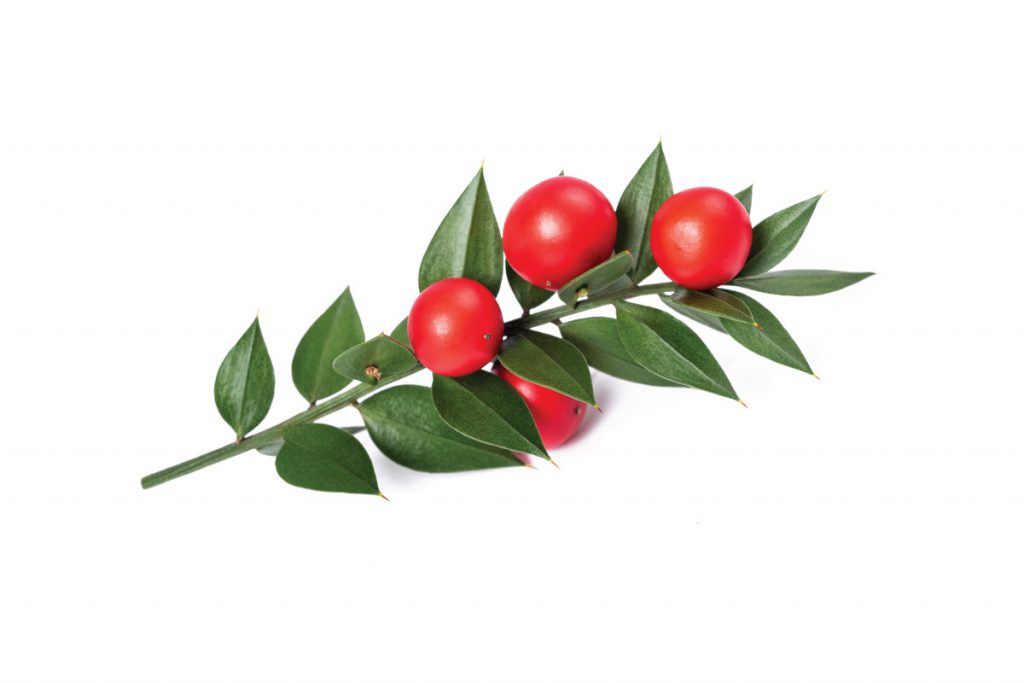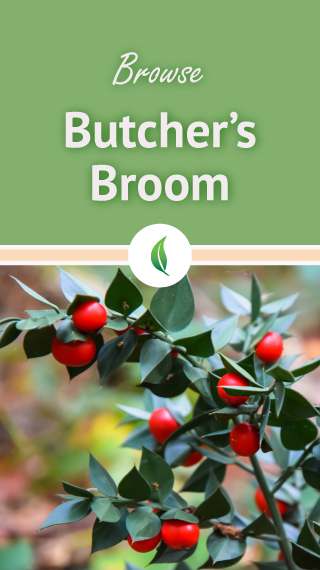
Butcher’s Broom Guide
August 15, 2022
Butcher’s Broom has been valued as a food source, ornamental shrub, and a natural remedy for centuries. Let’s find out what’s behind this herb with the funny name.
In This Healthy Insight:
- What is Butcher’s Broom? (Ruscus aculeatus)
- What are other names for Butcher’s Broom?
- What are the benefits of Butcher’s Broom?
- How does Butcher’s Broom work?
- How do you take Butcher’s Broom?

What is Butcher’s Broom? (Ruscus aculeatus)
A member of the lily family, Butcher’s broom, also commonly known as box holly, is a small, low-growing evergreen shrub, native to Western Europe. It comes in male and female varieties, both with stiff, tough branches and prickly leaves. Only the female bears shiny red berries. According to history, its name comes from the fact that butchers would bundle the branches together to form a broom which they used to sweep the gunk off their cutting boards. It was also used to ward off rodents from their meat.
With shoots similar to asparagus in shape, butcher’s broom was used as a food source, although they taste much more bitter than asparagus. Typically, it’s the stems and roots used to create nutritional supplements.
What are other names for Butcher’s Broom?
Butcher’s Broom is also known as: Box Holly, Fragon, Jew’s Myrtle, Kneeholm, Knee Holly, Petit Houx, Pettigree, Sweet Broom, Rusci Aculeati, Rhizoma, Rusco, Ruscus aculeatus. Do not confuse Butcher’s Broom with Broom Cytisus scoparius) or Spanish broom (Spartium junceum).

What are the benefits of Butcher’s Broom?
Butcher’s broom has had a prominent medicinal role for centuries. In European folk remedies, the root of butcher’s broom was used to encourage bowel movements and to remove fluids from the body by increasing urination. It was also used for stomach aches, eliminating kidney stones and to promote bone healing.
Although it was used for centuries in extracts and poultices, it wasn’t until the 1950s that it became mainstream.
Today Butcher’s Broom is commonly used for leg circulation, such as cramps, swelling, varicose veins, and itching. Occasionally, herbalists may use this herb for kidney health, heart health, or hemorrhoids.
How does Butcher’s Broom work?
Butcher’s broom contains called saponins (neoruscogenin, ruscogenen, ruscogenins) and bioflavonoids that researchers believe cause constriction of arteries and veins, particularly in the legs. One constituent, Rutin, is thought to decrease the permeability of blood vessels and increase vessel strength. Other natural components include:
- Phenolic compounds
- Sterols
- Coumarins
- Tyramine
- Sparteine
- Glycolic acid
How do you take Butcher’s Broom?
Butcher’s broom is often combined with other circulatory herbs including hawthorn, witch hazel and horse chestnut to make it even more effective. Botanic Choice offers Butcher’s Broom in capsules as a single extract and in blends for heart and circulation. Be sure to check out our best-selling Butcher’s Broom supplements now.



